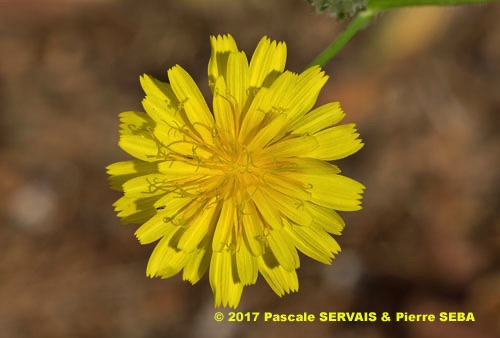
Picris rhagadioloides (L.) Desf.
Fam. : Asteraceae
© Pascale SERVAIS & Pierre SEBA, 2018. Tilo Botanica: Flore de Tilos et du Dodécanèse / Flora of Tilos and of the Dodecanese
English translation by Brenda Bradbury, Howard Bradbury and Stéphane Léonard
Plante herbacée, hermaphrodite, à tiges cylindriques, ramifiées, à poils crochus, de 4 à 5 mm de diamètre.
Feuilles à la base et alternes, à poils raides et crochus, celles de la base simples, oblongues à obovales, de 12 à 15 cm de long, de 33 à 43 mm de large, longuement spatulées, lobées, à bords ondulés, les caulinaires simples, linéaires, entières, de 5 cm de long, de 9 mm de large, à 2 petits lobes basaux embrassants.
Fleurs réunies en capitules nombreux, de 18 à 30 mm de diamètre, à pédoncules très longs, étalés, divariqués, non renflés au sommet, à fleurons tous ligulés, jaune vif, unis, à veines brun rougeâtre au revers. Involucre à 2 rangées de bractées linéaires à lancéolées, à poils crochus, les externes plus courtes que les internes, élargi en nacelle à la fructification. Ovaire infère.
Fruits, akènes à aigrette, bruns, glabres, courbées en forme de croissant, de 2,5 à 3 mm de long, de moins de 1 mm de large, à 12 à 18 arêtes transversales très saillantes, à bec minuscule ou nul. Akènes extérieurs avec un court pappus de poils rugueux, akènes intérieurs avec un long pappus de poils plumeux.
___________________________
Plant herbaceous, hermaphrodite. Stems cylindrical, branched, with hooked hairs, from 4 to 5 mm in diameter.
Leaves at the base and alternate, with stiff and hooked hairs, those of the base simple, oblong to obovate, from 12 to 15 cm long, from 33 to 43 mm across, lengthily spatulate, lobed, with undulated edges, stem-leaves simple, linear, entire, 5 cm long, 9 mm across, with 2 small clasping basal lobes.
Flowers joined together in numerous capitula, from 18 to 30 mm in diameter, with peduncles very long, spread out, divaricated, nonswollen at the top, with only ray-florets, bright yellow, self-coloured, with reddish brown veins in the lower part. Involucre with 2 rows of linear to lanceolate bracts, with hooked hairs, the external ones shorter than the internal ones, widened out in nacelle at fructification. Ovary inferior.
Fruits, achenes with pappus, brown, glabrous, curved, crescent-shaped, from 2.5 to 3 mm long, less than 1 mm across, with 12 to 18 very protruding transversal awns, with beak tiny or null. External achenes with short pappus of rough hairs, interior achenes with a long pappus of feathery hairs.
Descripteurs / Identifying features
1
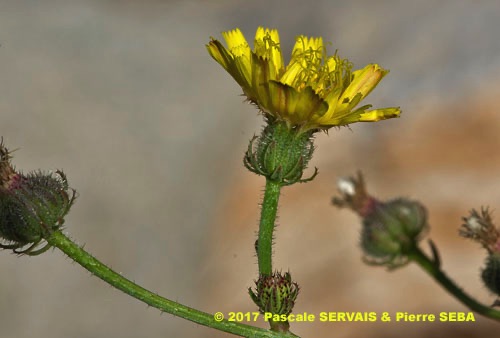
2
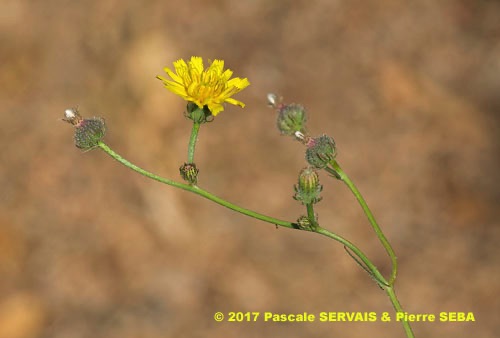
3
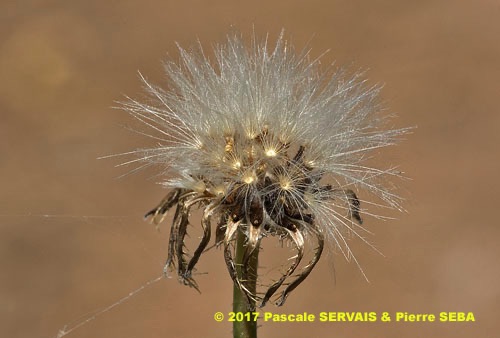
4
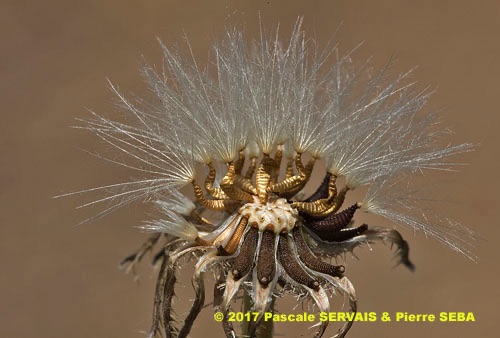
5
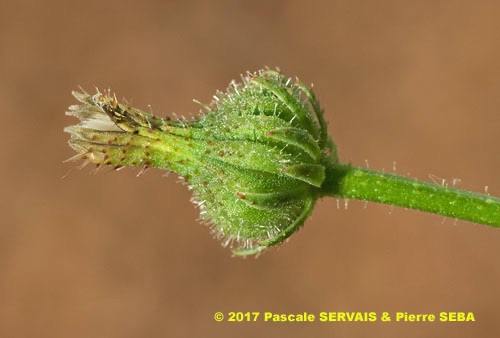
6
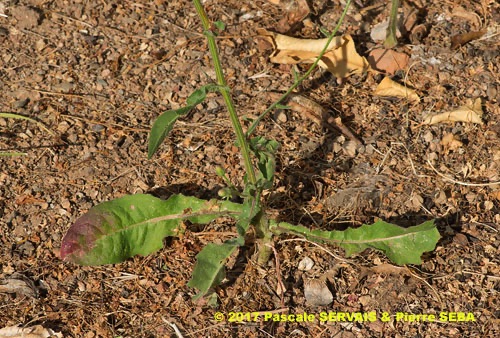
7
Étymologie / Etymology :
Picris : emprunt du latin picris, -idis (nom) = la picride, nom
donné à une sorte de laitue amère par Pline, naturaliste latin mort en
79 apr. J.-C., forme latinisée du grec ancien πικρίς, -ίδος (nom)
[ < πικρός, -ά, -όν (adj.) = piquant, amer ] = la picride, nom donné à
une sorte de laitue amère par Théophraste, philosophe péripatéticien,
disciple d’Aristote, botaniste et naturaliste, mort vers 288 av. J.-C., en
référence au goût très amer de la plante.
Rhagadioloides : emprunt du latin rhagadiolus, -i (nom) = nom d’une
plante de la famille des Asteraceae + εἶδος, -ους (nom)
= l’apparence, l’aspect. L’adjectif rhagadioloides signifie :
qui a l’apparence d’un rhagadiolus.
Picris : borrowed from Latin picris, -idis (noun) = oxtongue,
name given to a kind of bitter lettuce by Plinius, Latin naturalist died in
79 AD, Latinized form of the Classical Greek πικρίς, -ίδος (noun)
[ < πικρός, -ά, -όν (adj) = spicy, bitter ] = oxtongue, name given to a
kind of bitter lettuce by Theophrastus, peripatetic philosopher, disciple
of Aristotle, botanist and naturalist, died towards 288 BC, referring to
the very bitter taste of the plant.
Rhagadioloides : borrowed from Latin rhagadiolus, -i (noun) = name of
a plant of the Asteraceae family + εἶδος, -ους (noun) = appearance,
aspect. The adjectiv rhagadioloides means : which has the
appearance of a rhagadiolus.
Synonymes / Synonyms :
Choeroseris rhagadioloides Link
Hieracium ciliatum Willd.
Medicusia aspera Moench
Picris altissima Delile
Picris aspera Poir.
Picris integrifolia Desf.
Picris laxa DC.
Picris rhagadioloides (L.) Pers.
Picris rhagadioloides F.W.Schmidt
Picris rigida Spreng.
Picris sprengeriana (L.) Poir.
Noms vernaculaires / Common names :
Noms français / French names :
Picride très élevée — Picris très élevé.
Nom anglais / English name :
Tall ox-tongue.
Nom allemand / German name :
Hohes Bitterkraut.
Noms italiens / Italian names :
Aspraggine altissima — Aspraggine altissimo —
Aspraggine simile al radicchio stellato.
Habitat :
Cultures - Lieux pierreux - Lieux incultes - Chemins.
Cultivated places - Stony places - Waste ground - Waysides.
Île / Island :
Tilos.
Hauteur / Height range :
De 30 cm à 1 m.
From 30 cm to 1 m.
Floraison / Flowering time :
D’avril à juillet.
From April to July.
Groupe / Classification :
Dicotylédones.
Dicotyledons.
Pérennité / Lifespan :
Annuelle.
Annual.
Description :
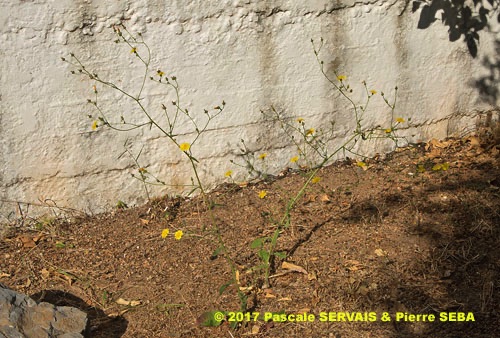
8
Photo 1 :
Localisation / Location : Tilos, Livadia, Village
Date : 05/06/2017
GPS : Lat. 36,41212° N / Long. 27,38807° E / Alt. 3 m
Type : Photographie numérique / Digital Photograph (24 mégapixels)
Photo 2 :
Localisation / Location : Tilos, Livadia, Village
Date : 05/06/2017
GPS : Lat. 36,41212° N / Long. 27,38807° E / Alt. 3 m
Type : Photographie numérique / Digital Photograph (24 mégapixels)
Photo 3 :
Localisation / Location : Tilos, Livadia, Village
Date : 05/06/2017
GPS : Lat. 36,41212° N / Long. 27,38807° E / Alt. 3 m
Type : Photographie numérique / Digital Photograph (24 mégapixels)
Photo 4 :
Localisation / Location : Tilos, Livadia, Village
Date : 05/06/2017
GPS : Lat. 36,41212° N / Long. 27,38807° E / Alt. 3 m
Type : Photographie numérique / Digital Photograph (24 mégapixels)
Photo 5 :
Localisation / Location : Tilos, Livadia, Village
Date : 05/06/2017
GPS : Lat. 36,41212° N / Long. 27,38807° E / Alt. 3 m
Type : Photographie numérique / Digital Photograph (24 mégapixels)
Photo 6 :
Localisation / Location : Tilos, Livadia, Village
Date : 05/06/2017
GPS : Lat. 36,41212° N / Long. 27,38807° E / Alt. 3 m
Type : Photographie numérique / Digital Photograph (24 mégapixels)
Photo 7 :
Localisation / Location : Tilos, Livadia, Village
Date : 05/06/2017
GPS : Lat. 36,41212° N / Long. 27,38807° E / Alt. 3 m
Type : Photographie numérique / Digital Photograph (24 mégapixels)
Photo 8 :
Localisation / Location : Tilos, Livadia, Village
Date : 05/06/2017
GPS : Lat. 36,41212° N / Long. 27,38807° E / Alt. 3 m
Type : Photographie numérique / Digital Photograph (24 mégapixels)

Google Maps
Google Maps
Google Maps
Google Maps
Google Maps
Google Maps
Google Maps
Google Maps